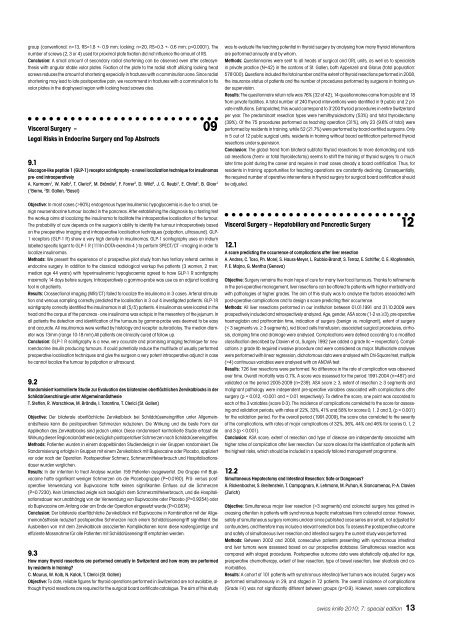Anorectal Manometry in 3D NEW! - Swiss-knife.org
Anorectal Manometry in 3D NEW! - Swiss-knife.org
Anorectal Manometry in 3D NEW! - Swiss-knife.org
Create successful ePaper yourself
Turn your PDF publications into a flip-book with our unique Google optimized e-Paper software.
group (conventional: n=13, RS=1.8 +- 0.9 mm; lock<strong>in</strong>g: n=20, RS=0.3 +- 0.6 mm; p90%) endogenous hyper<strong>in</strong>sul<strong>in</strong>emic hypoglycaemia is due to a small, benign<br />
neuroendocr<strong>in</strong>e tumour located <strong>in</strong> the pancreas. After establish<strong>in</strong>g the diagnosis by a fast<strong>in</strong>g test<br />
the workup aims at localiz<strong>in</strong>g the <strong>in</strong>sul<strong>in</strong>oma to facilitate the <strong>in</strong>traoperative localisation of the tumour.<br />
The probability of cure depends on the surgeon’s ability to identify the tumour <strong>in</strong>traoperatively based<br />
on the preoperative imag<strong>in</strong>g and <strong>in</strong>traoperative localisation techniques (palpation, ultrasound). GLP-<br />
1 receptors (GLP-1 R) show a very high density <strong>in</strong> <strong>in</strong>sul<strong>in</strong>omas. GLP-1 sc<strong>in</strong>tygraphy uses an <strong>in</strong>dium<br />
labelled specific ligant to GLP-1 R (111In-DOTA-exend<strong>in</strong>-4 ) to perform SPECT/CT –imag<strong>in</strong>g <strong>in</strong> order to<br />
localize <strong>in</strong>sul<strong>in</strong>omas.<br />
Methods: We present the experience of a prospective pilot study from two tertiary referral centres <strong>in</strong><br />
endocr<strong>in</strong>e surgery. In addition to the classical radiological workup five patients (3 women, 2 men;<br />
median age 44 years) with hyper<strong>in</strong>sul<strong>in</strong>emic hypoglycaemia agreed to have GLP-1 R sc<strong>in</strong>tigraphy<br />
maximally 14 days before surgery. Intraoperatively a gamma-probe was use as an adjunct localiz<strong>in</strong>g<br />
tool <strong>in</strong> all patients.<br />
Results: Crossectional imag<strong>in</strong>g (MRI/CT) failed to localize the <strong>in</strong>sul<strong>in</strong>oma <strong>in</strong> 3 cases. Arterial stimulation<br />
and venous sampl<strong>in</strong>g correctly predicted the localisation <strong>in</strong> 3 out 4 <strong>in</strong>vestigated patients. GLP-1R<br />
sc<strong>in</strong>tigraphy correctly identified the <strong>in</strong>sul<strong>in</strong>omas <strong>in</strong> all (5/5) patients. 4 <strong>in</strong>sul<strong>in</strong>omas were located <strong>in</strong> the<br />
head and the corpus of the pancreas - one <strong>in</strong>sul<strong>in</strong>oma was ectopic <strong>in</strong> the mesentery of the jejunum. In<br />
all patients the detection and identification of the tumours by gamma-probe was deemed to be easy<br />
and accurate. All <strong>in</strong>sul<strong>in</strong>omas were verified by histology and receptor autoradioloy. The median diameter<br />
was 13mm (range 10-18 mm).All patients are cl<strong>in</strong>ically cured at follow up.<br />
Conclusion: GLP-1 R sc<strong>in</strong>tigraphy is a new, very accurate and promis<strong>in</strong>g imag<strong>in</strong>g technique for neuroendocr<strong>in</strong>e<br />
<strong>in</strong>sul<strong>in</strong> produc<strong>in</strong>g tumours. It could potentially reduce the multitude of usually performed<br />
preoperative localisation techniques and give the surgeon a very potent <strong>in</strong>traoperative adjunct <strong>in</strong> case<br />
he cannot localize the tumour by palpation or ultrasound.<br />
9.2<br />
Randomisiert kontrollierte Studie zur Evaluation des bilateralen oberflächlichen Zervikalblocks <strong>in</strong> der<br />
Schilddrüsenchirurgie unter Allgeme<strong>in</strong>anästhesie<br />
T. Steffen, R. Warschkow, M. Brändle, I. Tarant<strong>in</strong>o, T. Clerici (St. Gallen)<br />
Objective: Der bilaterale oberflächliche Zervikalblock bei Schilddrüsene<strong>in</strong>griffen unter Allgeme<strong>in</strong>anästhesie<br />
kann die postoperativen Schmerzen reduzieren. Die Wirkung und die beste Form der<br />
Applikation des Zervikalblocks s<strong>in</strong>d jedoch unklar. Diese randomisiert kontrollierte Studie erfasst die<br />
Wirkung dieser Regionalanästhesie bezüglich postoperativer Schmerzen nach Schilddrüsene<strong>in</strong>griffen.<br />
Methods: Patienten wurden <strong>in</strong> e<strong>in</strong>em doppelbl<strong>in</strong>den Studiendesign <strong>in</strong> vier Gruppen randomisiert. Die<br />
Randomisierung erfolgte <strong>in</strong> Gruppen mit e<strong>in</strong>em Zervikalblock mit Bupivaca<strong>in</strong>e oder Placebo, appliziert<br />
vor oder nach der Operation. Postoperativer Schmerz, Schmerzmittelverbrauch und Hospitalisationsdauer<br />
wurden verglichen.<br />
Results: In der <strong>in</strong>tention to treat Analyse wurden 159 Patienten ausgewertet. Die Gruppe mit Bupivaca<strong>in</strong>e<br />
hatte signifikant weniger Schmerzen als die Placebogruppe (P=0.0160). Prä- versus postoperative<br />
Verwendung von Bupivaca<strong>in</strong>e hatte ke<strong>in</strong>en signifikanten E<strong>in</strong>fluss auf die Schmerzen<br />
(P=0.7230). Ke<strong>in</strong> Unterschied zeigte sich bezüglich dem Schmerzmittelverbrauch, und die Hospitalisationsdauer<br />
war unabhängig von der Verwendung von Bupivaca<strong>in</strong>e oder Placebo (P=0.9254) oder<br />
ob Bupivaca<strong>in</strong>e am Anfang oder am Ende der Operation e<strong>in</strong>gesetzt wurde (P=0.0874).<br />
Conclusion: Der bilaterale oberflächliche Zervikalblock mit Bupivaca<strong>in</strong>e <strong>in</strong> Komb<strong>in</strong>ation mit der Allgeme<strong>in</strong>anästhesie<br />
reduziert postoperative Schmerzen nach e<strong>in</strong>em Schilddrüsene<strong>in</strong>griff signifikant. Bei<br />
Ausbleiben von mit dem Zervikalblock assoziierten Komplikationen kann diese kostengünstige und<br />
effiziente Massnahme für alle Patienten mit Schilddrüsene<strong>in</strong>griff empfohlen werden.<br />
9.3<br />
How many thyroid resections are performed annually <strong>in</strong> Switzerland and how many are performed<br />
by residents <strong>in</strong> tra<strong>in</strong><strong>in</strong>g?<br />
C. Maurus, W. Kolb, N. Kalak, T. Clerici (St. Gallen)<br />
Objective: To date, reliable figures for thyroid operations performed <strong>in</strong> Switzerland are not available, although<br />
thyroid resections are required for the surgical board certificate catalogue. The aim of this study<br />
was to evaluate the teach<strong>in</strong>g potential <strong>in</strong> thyroid surgery by analys<strong>in</strong>g how many thyroid <strong>in</strong>terventions<br />
are performed annually and by whom.<br />
Methods: Questionnaires were sent to all heads of surgical and ORL units, as well as to specialists<br />
<strong>in</strong> private practice (N=42) <strong>in</strong> the cantons of St. Gallen, both Appenzell and Glarus (total population:<br />
578’000). Questions <strong>in</strong>cluded the total number and the extent of thyroid resections performed <strong>in</strong> 2008,<br />
the <strong>in</strong>surance status of patients and the number of procedures performed by surgeons <strong>in</strong> tra<strong>in</strong><strong>in</strong>g under<br />
supervision.<br />
Results: The questionnaire return rate was 76% (32 of 42), 14 questionnaires came from public and 18<br />
from private facilities. A total number of 240 thyroid <strong>in</strong>terventions were identified <strong>in</strong> 9 public and 2 private<br />
<strong>in</strong>stitutions. Extrapolated, this would correspond to 3’200 thyroid procedures <strong>in</strong> entire Switzerland<br />
per year. The predom<strong>in</strong>ant resection types were hemithyroidectomy (53%) and total thyroidectomy<br />
(39%). Of the 75 procedures performed as teach<strong>in</strong>g operation (31%), only 23 (9.6% of total) were<br />
performed by residents <strong>in</strong> tra<strong>in</strong><strong>in</strong>g, while 52 (21.7%) were performed by board-certified surgeons. Only<br />
<strong>in</strong> 5 out of 12 public surgical units, residents <strong>in</strong> tra<strong>in</strong><strong>in</strong>g without board certification performed thyroid<br />
resections under supervision.<br />
Conclusion: The global trend from bilateral subtotal thyroid resections to more demand<strong>in</strong>g and radical<br />
resections (hemi- or total thyroidectomy) seems to shift the tra<strong>in</strong><strong>in</strong>g of thyroid surgery to a much<br />
later time po<strong>in</strong>t dur<strong>in</strong>g the career and requires <strong>in</strong> most cases already a board certification. Thus, for<br />
residents <strong>in</strong> tra<strong>in</strong><strong>in</strong>g opportunities for teach<strong>in</strong>g operations are constantly decl<strong>in</strong><strong>in</strong>g. Consequentially,<br />
the required number of operative <strong>in</strong>terventions <strong>in</strong> thyroid surgery for surgical board certification should<br />
be adjusted.<br />
Visceral Surgery – Hepatobiliary and Pancreatic Surgery 12<br />
12.1<br />
A score predict<strong>in</strong>g the occurrence of complications after liver resection<br />
A. Andres, C. Toso, Ph. Morel, S. Hauss-Meyer, L. Rubbia-Brandt, S. Terraz, E. Schiffer, C. E. Klopfenste<strong>in</strong>,<br />
P. E. Majno, G. Mentha (Geneva)<br />
Objective: Surgery rema<strong>in</strong>s the ma<strong>in</strong> hope of cure for many liver focal tumours. Thanks to ref<strong>in</strong>ements<br />
<strong>in</strong> the peri-operative management, liver resections can be offered to patients with higher morbidity and<br />
with pathologies of higher grades. The aim of this study was to analyse the factors associated with<br />
post-operative complications and to design a score predict<strong>in</strong>g their occurrence.<br />
Methods: All liver resections performed <strong>in</strong> our <strong>in</strong>stitution between 01.01.1991 and 31.10.2009 were<br />
prospectively <strong>in</strong>cluded and retrospectively analyzed. Age, gender, ASA score (1-2 vs ≥3), pre-operative<br />
haemoglob<strong>in</strong> and prothromb<strong>in</strong> time, <strong>in</strong>dication of surgery (benign vs. malignant), extent of surgery<br />
(< 3 segments vs. ≥ 3 segments), red blood cells transfusion, associated surgical procedures, cirrhosis,<br />
clamp<strong>in</strong>g time and dra<strong>in</strong>age were analysed. Complications were def<strong>in</strong>ed accord<strong>in</strong>g to a modified<br />
classification described by Clavien et al., Surgery 1992 (we added a grade IIc = reoperation). Complications<br />
≥ grade IIb required <strong>in</strong>vasive procedure and were considered as major. Multivariate analyses<br />
were performed with l<strong>in</strong>ear regression, dichotomous data were analysed with Chi-Square test, multiple<br />
(>4) cont<strong>in</strong>uous variables were analysed with an ANOVA test.<br />
Results: 726 liver resections were performed. No difference <strong>in</strong> the rate of complication was observed<br />
over time. Overall mortality was 0.7%. A score was assessed for the period 1991-2004 (n=487) and<br />
validated on the period 2005-2009 (n=239). ASA score ≥ 3, extent of resection ≥ 3 segments and<br />
malignant pathology were <strong>in</strong>dependent pre-operative variables associated with complications after<br />
surgery (p = 0.012, 3 segments) and colorectal surgery has ga<strong>in</strong>ed <strong>in</strong>creas<strong>in</strong>g<br />
attention <strong>in</strong> patients with synchronous hepatic metastases from colorectal cancer. However,<br />
safety of simultaneous surgery rema<strong>in</strong>s unclear s<strong>in</strong>ce published case series are small, not adjusted for<br />
confounders, and therefore may <strong>in</strong>clude a relevant selection bias. To assess the postoperative outcome<br />
and safety of simultaneous liver resection and <strong>in</strong>test<strong>in</strong>al surgery the current study was performed.<br />
Methods: Between 2002 and 2008, consecutive patients present<strong>in</strong>g with synchronous <strong>in</strong>test<strong>in</strong>al<br />
and liver tumors were assessed based on our prospective database. Simultaneous resection was<br />
compared with staged procedures. Postoperative outcome data were statistically adjusted for age,<br />
preoperative chemotherapy, extent of liver resection, type of bowel resection, liver steatosis and comorbidities.<br />
Results: A cohort of 101 patients with synchronous <strong>in</strong>test<strong>in</strong>al/liver tumors was <strong>in</strong>cluded. Surgery was<br />
performed simultaneously <strong>in</strong> 29, and staged <strong>in</strong> 72 patients. The overall <strong>in</strong>cidence of complications<br />
(Grade I-V) was not significantly different between groups (p=0.9). However, severe complications<br />
swiss <strong>knife</strong> 2010; 7: special edition 13
















